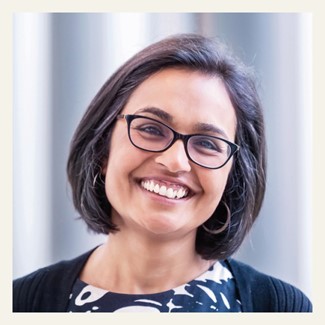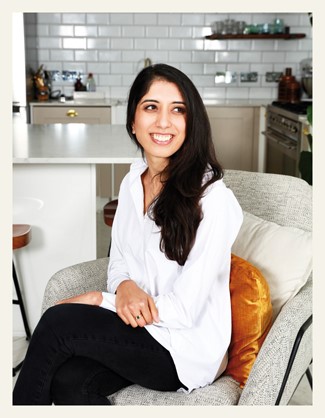-
PDF
- Split View
-
Views
-
Cite
Cite
Judith Ozkan, Taking root: how a fresh approach to nutrition is tackling heart disease amongst South Asian populations, European Heart Journal, Volume 43, Issue 5, 1 February 2022, Pages 355–356, https://doi.org/10.1093/eurheartj/ehab410
Close - Share Icon Share
A group of health professionals dedicated to reducing high rates of cardiovascular disease (CVD) and type 2 diabetes (T2D) are calling for a plant- based approach to reduce risk factors and support healthier lifestyles within South Asian populations. Rohini Bajekal, MA Oxon, MSc, and Shireen Kassam, MBBS, PhD, are British Asians who became concerned by the way their families and communities were disproportionately affected by chronic conditions and decided to tackle some of the contributing factors. Shireen—a consultant haematologist at London’s King’s College Hospital, who has first-hand experience of heart disease in her own family—set up the community interest company Plant-Based Health Professionals UK (PBHP UK) to promote healthier eating and to reduce or even reverse the incidence of CVD and T2D amongst South Asians and other communities in the UK (Figure 1).

Shireen Kassam, MBBS, PhD, founder of Plant Based Health Professionals UK.
The work of PBHP UK—which now numbers some 800 members—has been informed by the MASALA study (Mediators of Atherosclerosis in South Asians Living in America).1 This longitudinal study was set up in 2006 by researchers at the University of California San Francisco (UCSF) in the USA to look into the main factors leading to high levels of CVD and T2D in US residents from countries including India, Pakistan, Sri Lanka, and the Maldives. MASALA identified South Asians as being four times more likely to develop heart disease compared to the general population. It also provided an insight into the genetic and environmental factors that influence health in this group. Rohini says: ‘There are huge parallels between the US and the UK, where the British Heart Foundation (BHF) has reported a 50 per cent higher risk for coronary heart disease (CHD) amongst South Asians. What is also important is the way MASALA homed in on the impact of diet quality on predispositions to disease risk’.
Specific data from the UK Biobank and South Asia Biobank studies highlighted similar findings to the MASALA study and laid out the higher risk factors likely to affect South Asians. The UK Biobank has also investigated whether commonly accepted identifiers of risk factors such as body mass index (BMI) were being used effectively or were giving South Asians a false sense of security. Shireen says: ‘Some defined risk factors used for the white European population don’t seem to be the same for South Asians, who with a BMI of 22, are at the same risk of T2D as a white individual with a BMI of 30. This is why we need a healthcare system that identifies culturally appropriate medical interventions’. Body image and different cultural perceptions of a healthy constitution can vary within South Asian communities and cause confusion. A fuller frame may be seen as a sign of a good lifestyle whereas a leaner look can be associated with poor health.
Although PBHP UK provides advice and advocacy on plant-based diets to all, the paucity of specific support for South Asian populations convinced Shireen and Rohini that a more culturally relevant approach to the prevention and treatment of chronic illness was needed. Shireen and Rohini’s own backgrounds as members of South Asian communities in the UK gives them an insight and empathy that enables them to tailor health prevention information and initiatives that are relatable. For example, advice about cutting back meat and alcohol is less relevant for some South Asians in the Jain, Hindu, and Sikh communities who are more likely to be vegetarian and abstain from alcohol. ‘It can also be confusing for people to appreciate that not all plant-based diets are healthy if they include a lot of deep-fried, high fat and sugary foods’, says Rohini. In addition, having a good understanding of a nutritionally balanced diet may not be enough on its own to tackle chronic conditions if there are other poor lifestyle factors. Shireen’s father experienced a heart attack in his 50s and Rohini’s father, an orthopaedic surgeon, had a number of chronic conditions linked to a busy and stressful lifestyle and carrying excess weight. Despite being educated professionals who were well informed about health, both sets of parents needed practical support and advice to effectively deal with challenging conditions. Rohini’s father used a whole food plant-based diet to reverse his diabetes and shed 17 kilos, and Shireen’s father who previously met the criteria for metabolic syndrome, including pre-diabetes, reversed back to a healthy weight, normalizing blood parameters, and is still working aged 77 (Figure 2).

Other cultural factors that present challenges to maintaining a healthy diet relate to celebrations around religious festivals, community, and family events where it is traditional to provide lavish hospitality and where many of the foods on offer are often high fat, deep fried and high sugar versions of dishes that should, ideally, be eaten sparingly. Another unhelpful ingredient common across South Asian cuisine is ghee, a clarified butter used for frying, basting, and tempering dishes, which Rohini describes as ‘oxidised cholesterol’. Whilst replacing fried snacks, refined carbohydrates and ghee on an everyday basis is beneficial, Shireen underlines that high rates of disease are not just down to individual lifestyle behaviours. ‘It’s also about the environment and the socio-economic factors which play a big part in the health outcomes of some of our migrant communities. We need to start with high up, structural changes in our food environment and put more of an emphasis on health promotion’. In the UK, it is estimated that less than 5% of the healthcare budget is spent on prevention and government health advice has to compete with a food industry that often promotes foods that are high in fat, sugar, and salt but low in quality.
With South Asians making up 25% of the World’s population and accounting for 60% of heart disease patients, prevention rather than cure would seem to be a wise option. Future projections of rising rates of CVD are a reason to improve and expand culturally relevant health education. Rohini says: ‘Plant-based nutrition is a cornerstone of disease prevention that goes hand in hand with all the other lifestyle factors, but there needs to be culturally relevant guidance to empower people to address their circumstances. We need to look at community and faith-based methods of intervention which have been shown to be powerful in terms of outcomes’. A major learning point from the MASALA study was, Shireen says, the way that health behaviours of children could impact positively on the health of the parents. This means that educating younger generations on the importance of activity and diet can be a useful step in establishing life-long awareness of beneficial lifestyle habits. A healthy plant-based diet is especially important for South Asian women to manage polycystic ovarian syndrome, pregnant women to avoid gestational diabetes, as well as for South Asian children, who are also disproportionately affected by childhood obesity and T2D.
Rohini says that it is also important to emphasise and build on those aspects of South Asian culture and culinary practices which lend themselves to successful interventions. When strong and supportive community networks get on board with healthy initiatives it creates a good environment for lasting change and helps individuals address their health concerns. The staples and basics of all South Asian diets—including cooking from scratch and meals based around pulses and vegetables are hugely beneficial and a familiarity with using spices and herbs for flavouring foods helps adapt dishes to make lower fat, sugar, oil, and salt versions. Rohini suggests ‘crowding out’ high fat foods and bringing in colourful whole plant foods where possible and recognizing that certain dishes should be enjoyed sparingly. PBHP have shown that it is never too soon or too late to adopt a whole food plant-based diet.
Far from being an alternative lifestyle choice, plant-based diets—defined as those derived from plant sources including vegetables, fruits, whole grains, nuts, and seeds are now embedded in scientific literature. Shireen says: ‘What we are doing to empower people to make active choices is in line with current thinking and guidelines such as the American College of Cardiology (ACC) on the prevention of CVD, but I think there needs to be a shift from actually having the science to implementing it on a public health level. It’s clear that healthcare systems will always need to prioritise life-saving treatments, but the value of prevention will not only be felt in the healthcare system, but also on a personal level for the individual, their family, and their community’.
Conflict of interest: none declared.



